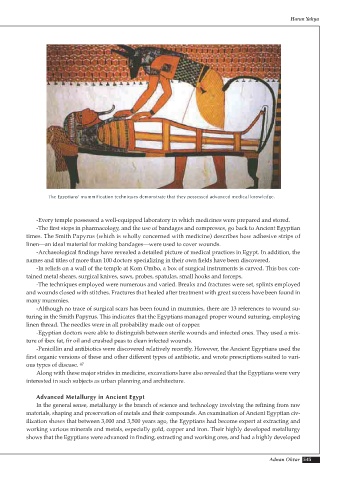Page 547 - Atlas of Creation Volume 2
P. 547
Harun Yahya
The Egyptians' mummification techniques demonstrate that they possessed advanced medical knowledge.
-Every temple possessed a well-equipped laboratory in which medicines were prepared and stored.
-The first steps in pharmacology, and the use of bandages and compresses, go back to Ancient Egyptian
times. The Smith Papyrus (which is wholly concerned with medicine) describes how adhesive strips of
linen—an ideal material for making bandages—were used to cover wounds.
-Archaeological findings have revealed a detailed picture of medical practices in Egypt. In addition, the
names and titles of more than 100 doctors specializing in their own fields have been discovered.
-In reliefs on a wall of the temple at Kom Ombo, a box of surgical instruments is carved. This box con-
tained metal shears, surgical knives, saws, probes, spatulas, small hooks and forceps.
-The techniques employed were numerous and varied. Breaks and fractures were set, splints employed
and wounds closed with stitches. Fractures that healed after treatment with great success have been found in
many mummies.
-Although no trace of surgical scars has been found in mummies, there are 13 references to wound su-
turing in the Smith Papyrus. This indicates that the Egyptians managed proper wound suturing, employing
linen thread. The needles were in all probability made out of copper.
-Egyptian doctors were able to distinguish between sterile wounds and infected ones. They used a mix-
ture of ibex fat, fir oil and crushed peas to clean infected wounds.
-Penicillin and antibiotics were discovered relatively recently. However, the Ancient Egyptians used the
first organic versions of these and other different types of antibiotic, and wrote prescriptions suited to vari-
ous types of disease. 47
Along with these major strides in medicine, excavations have also revealed that the Egyptians were very
interested in such subjects as urban planning and architecture.
Advanced Metallurgy in Ancient Egypt
In the general sense, metallurgy is the branch of science and technology involving the refining from raw
materials, shaping and preservation of metals and their compounds. An examination of Ancient Egyptian civ-
ilization shows that between 3,000 and 3,500 years ago, the Egyptians had become expert at extracting and
working various minerals and metals, especially gold, copper and iron. Their highly developed metallurgy
shows that the Egyptians were advanced in finding, extracting and working ores, and had a highly developed
Adnan Oktar 545

